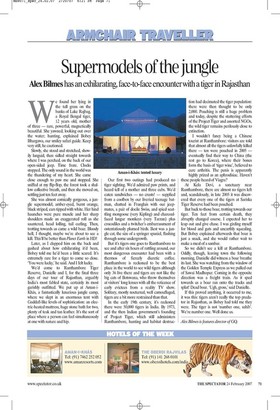Supermodels of the jungle
Alex Bilmes has an exhilarating, face-to-face encounter with a tiger in Rajasthan We found her lying in the tall grass on the banks of Lake Rajbag, a Royal Bengal tiger, 12 years old, mother of three — rare, powerful, magnetically beautiful. She yawned, looking out over the water; hunting, explained Bobey Bhargawa, our smiley safari guide. Keep very still, he cautioned.
Slowly, she stood and stretched, showily languid, then sidled straight towards where I was perched, on the back of our open-sided jeep. Time froze. Clocks stopped. The only sound in the world was the thundering of my heart. She came close enough to paw me and stopped. She sniffed at my flip-flop, the forest took a shallow collective breath, and then she moved on, settling just ten feet away.
She was almost comically gorgeous, a jungle supermodel, amber-eyed, burnt orange, black striped, ears tipped with white. Her hind haunches were pure muscle and her sharp shoulders made an exaggerated roll as she sauntered, head lolling, tail curling. Then, trotting towards us came a wild boar. Bloody hell, I thought, maybe we're about to see a kill. This'll be better than Planet Earth in HD!
Later, as I clapped him on the back and gushed about how exhilarating it'd been, Bobey told me he'd been a little scared. It's extremely rare for a tiger to come so close. 'You were lucky,' he said. And I felt lucky.
We'd come to Ranthambore Tiger Reserve, Danielle and I, for the final three days of our tour of Rajasthan, arguably India's most fabled state, certainly its most garishly outfitted. We put up at Aman-iKhas, a fantastically luxurious jungle camp, where we slept in an enormous tent with Gaddafi-like levels of sophistication: an electric-heated mattress, huge stone bath for two, plenty of teak and tan leather. It's the sort of place where a person can feel simultaneously at one with nature and hip.
Our first two outings had produced no tiger sighting. We'd admired paw prints, and heard tell of a mother and three cubs. We'd eaten sandwiches — no crusts! — supplied from a coolbox by our liveried teenage batman, chatted in Franglais with our jeepmates, a pair of docile Swiss, and spied scuttling mongoose (very Kipling) and charcoalfaced langur monkeys (very Tarzan) plus crocodiles and a twitcher's embarrassment of ostentatiously plumed birds. Best was a jungle cat, the size of a springer spaniel, flashing through some undergrowth.
But it's tigers one goes to Ranthambore to see and after six hours of rattling around, our most dangerous encounter had been with a thermos of fiercely diuretic coffee. Ranthambore is reckoned to be the best place in the world to see wild tigers although only 36 live there and tigers are not like the big cats of Botswana, who throw themselves at visitors' long lenses with all the reticence of early evictees from a reality TV show. Solitary, mostly nocturnal, well camouflaged, tigers are a bit more restrained than that.
In the early 19th century, it's reckoned there were 50,000 tigers in India. By 1973, and the then Indian government's founding of Project Tiger, which still administers Ranthambore, hunting and habitat destruction had decimated the tiger population: there were then thought to be only 2,000. Poaching is still a huge problem and today, despite the stuttering efforts of the Project Tiger and assorted NG0s, the wild tiger remains perilously close to extinction.
I wouldn't fancy being a Chinese tourist at Ranthambore: visitors are told that almost all the tigers unlawfully killed there — ten were poached in 2005 — eventually find their way to China (the rest go to Korea), where their bones form the basis of 'tiger wine', believed to cure arthritis. The penis is apparently highly prized as an aphrodisiac. Haven't these people heard of Viagra?
At Kela Devi, a sanctuary near Ranthambore, there are almost no tigers left and, scandalously, in late 2005 it was discovered that every one of the tigers at Sariska Tiger Reserve had been poached.
But back to those boar, trotting towards our tiger. Ten feet from certain death, they abruptly changed course. I expected her to leap out and give chase. I was girding myself for blood and guts and unearthly squealing. But Bobey explained afterwards that boar is just a snack, and she would rather wait to make a meal of a sambar.
So we didn't see a kill at Ranthambore. Oddly, though, leaving town the following morning, Danielle did witness a boar breathe its last. She was watching from the window of the Golden Temple Express as we pulled out of Sawai Madhopur. Coming in the opposite direction was a freight train. As it sped towards us a boar ran onto the tracks and splat! Dead boar. 'Ugh, gross,' said Danielle.
If this proved anything, it occurred to me, it was this: tigers aren't really the top predator in Rajasthan, as Bobey had told me they were. The tiger is not 'number one, sahib'. We're number one. Well done us.
Alex Bilmes is features director of GQ.






















































 Previous page
Previous page